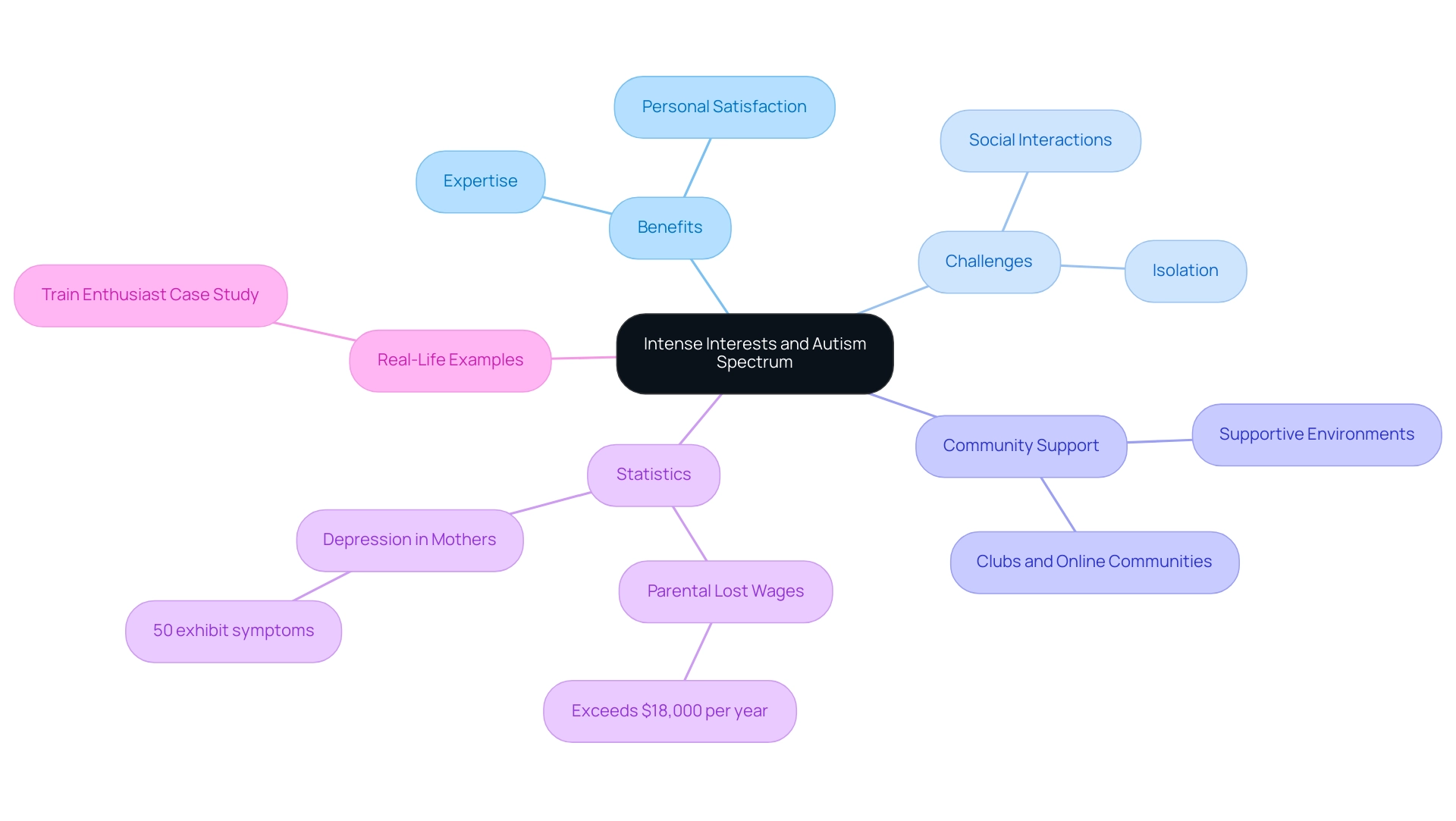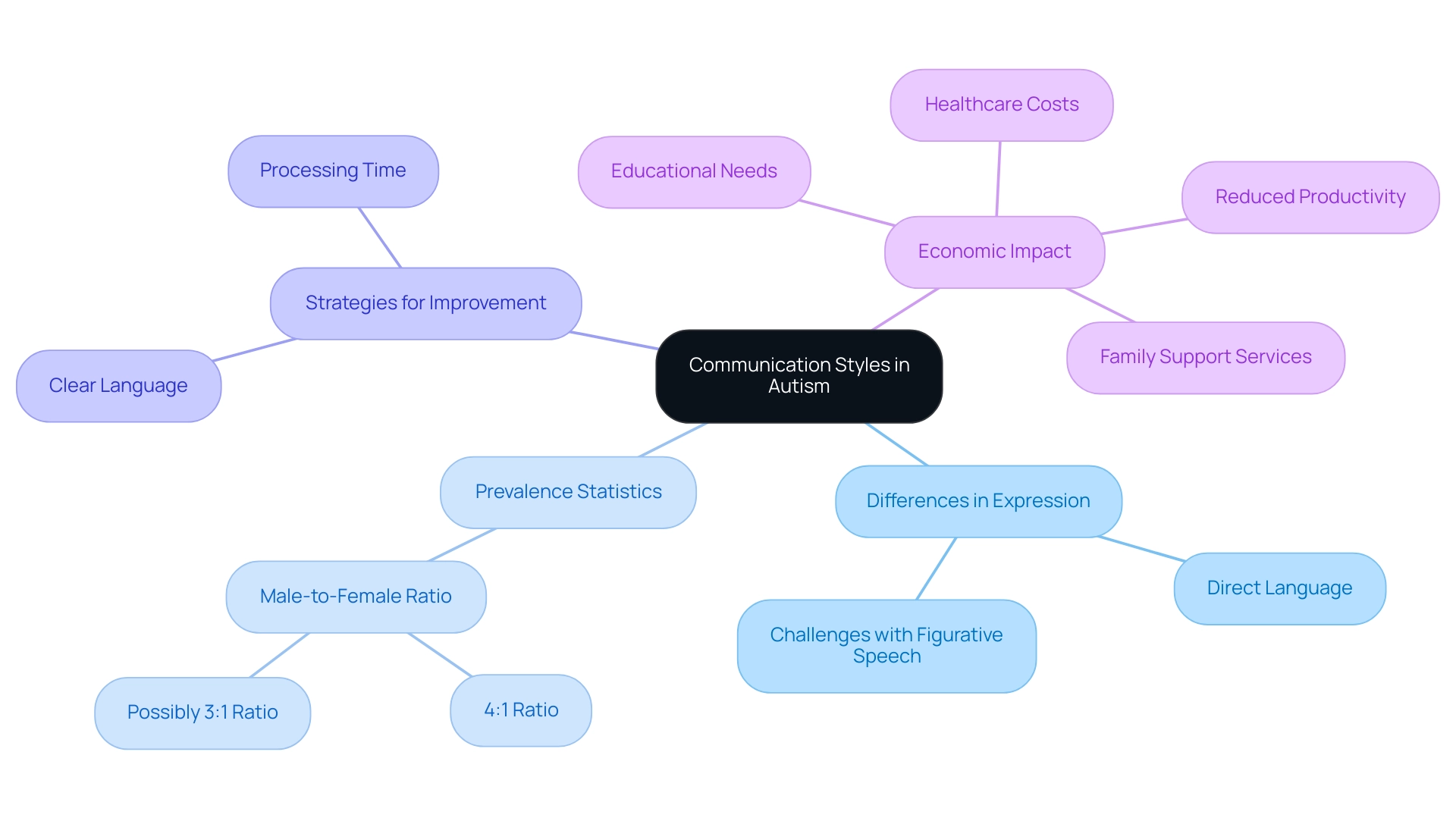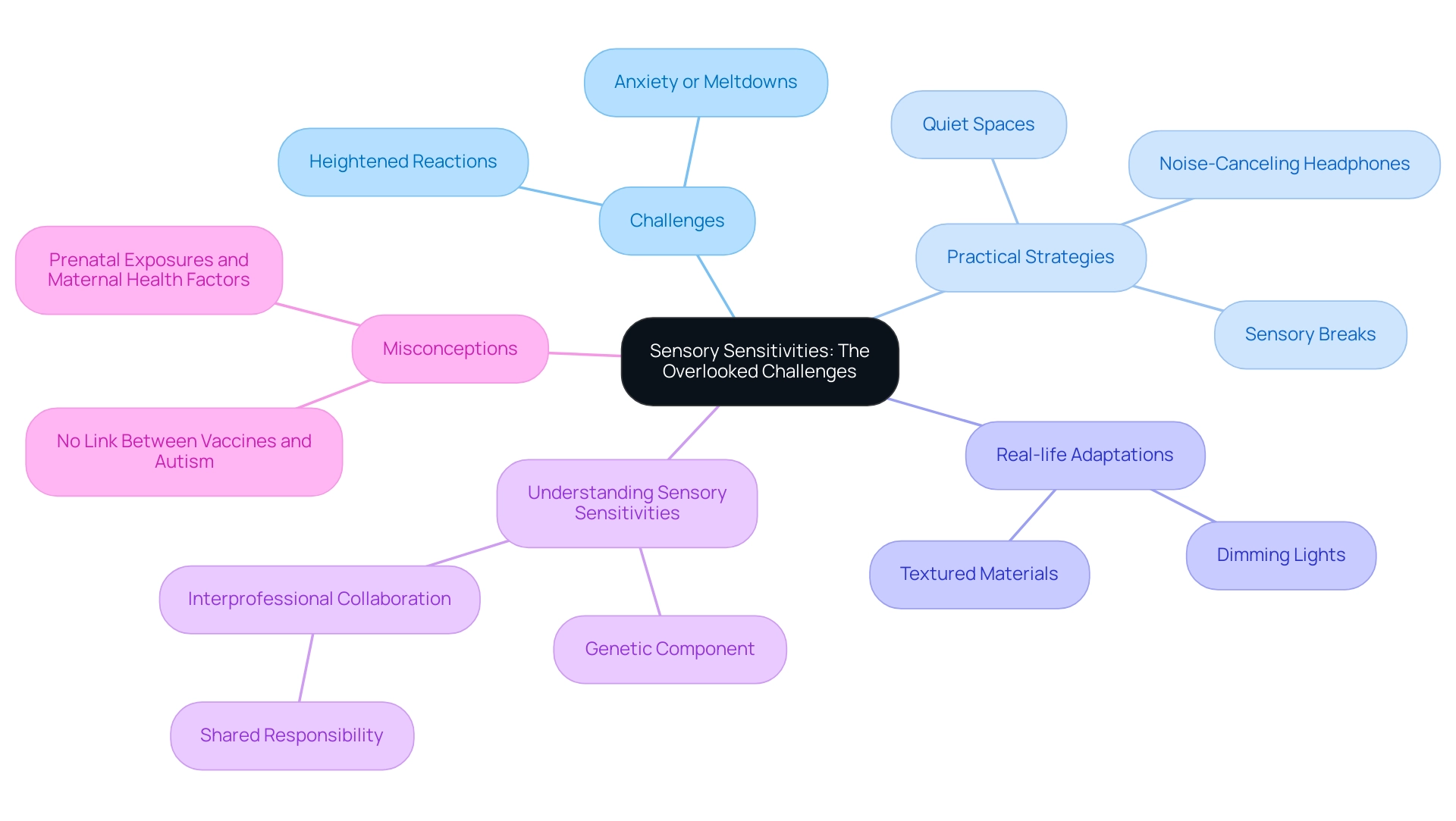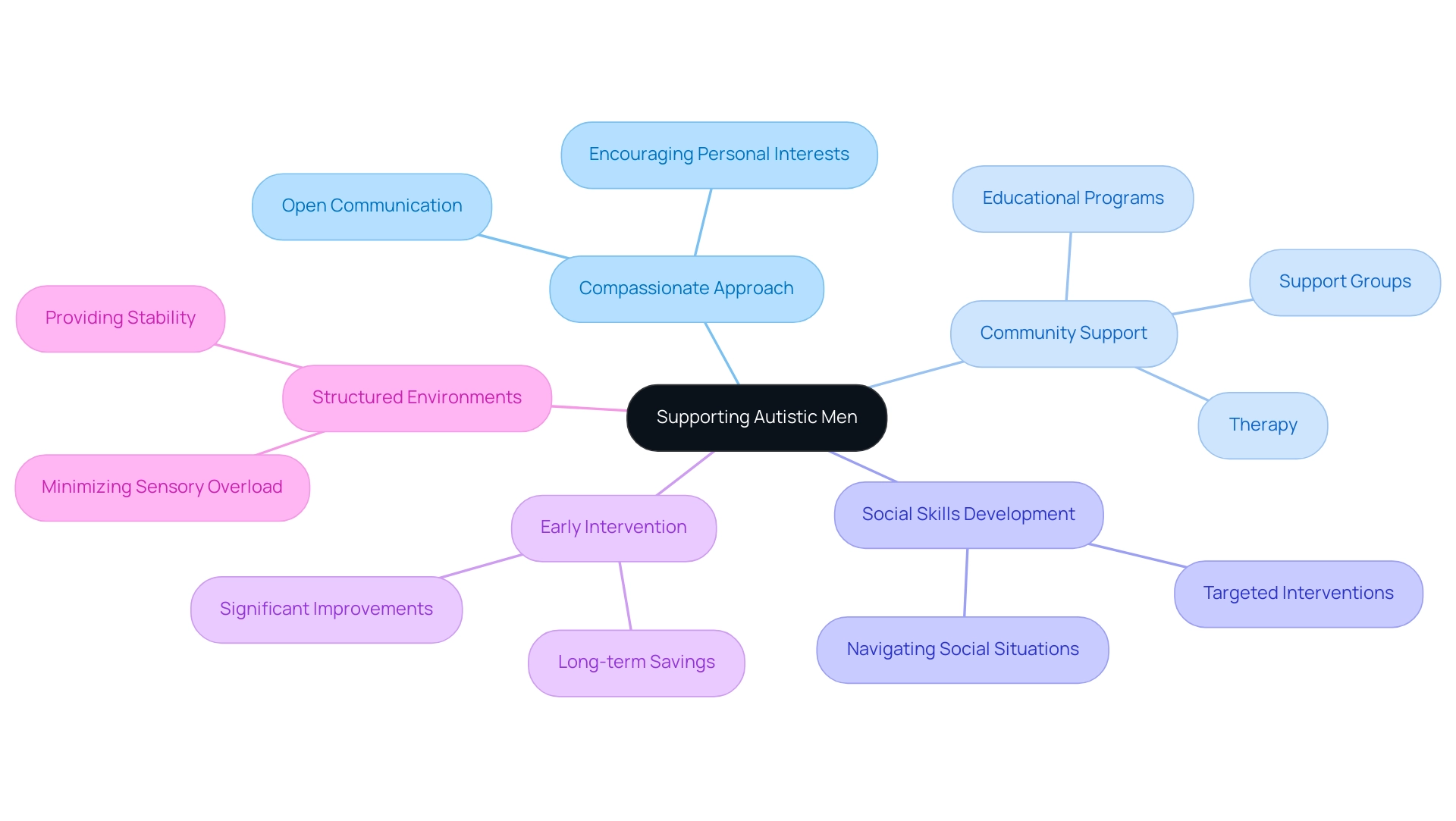Overview
This article delves into the understanding of autism symptoms in men, shining a light on the unique challenges they encounter in social interactions, communication, and sensory processing. By highlighting key symptoms—such as communication difficulties, intense interests, and sensory sensitivities—it illustrates how these aspects profoundly affect their daily lives and mental health. This underscores the urgent need for tailored support and heightened awareness within our communities. We invite you to join us in fostering a more understanding environment, where these men can thrive and receive the support they truly deserve.
Introduction
In a world that is increasingly attuned to the nuances of neurodiversity, understanding Autism Spectrum Disorder (ASD) has never been more crucial. This multifaceted condition presents a wide array of challenges, especially for men, who often exhibit unique symptoms and coping strategies. Recent estimates indicate that 1 in 36 children in the U.S. are diagnosed with autism, highlighting an urgent need for awareness and support. From difficulties in social interactions to intense interests that shape identities, the experiences of autistic men are as diverse as they are complex. As society grapples with the rising prevalence of autism and the disparities in diagnosis across different demographic groups, it becomes essential to foster understanding and create supportive environments that empower individuals on the spectrum.
This article delves into the intricacies of autism in men, exploring key symptoms, communication styles, sensory sensitivities, and strategies for effective support. Ultimately, our aim is to enhance the quality of life for those affected, inviting readers to join us on this journey of understanding and compassion.
Defining Autism: An Overview of the Spectrum
Autism, or Autism Spectrum Disorder (ASD), is a multifaceted neurodevelopmental condition that presents a diverse array of challenges in social interaction, communication, and behavior. The term 'spectrum' aptly describes the wide range of symptoms and abilities exhibited by individuals with developmental differences. While some may face significant challenges, others may function at a high level, showcasing the complexity of the disorder.
This variability is particularly evident in men, who often display distinct symptoms and coping strategies that differ from those of women. Understanding these differences is crucial for fostering an inclusive environment.
Current expert views emphasize the importance of comprehending these traits, especially as the incidence of this condition continues to increase. Recent estimates indicate that approximately 1 in 36 children in the U.S. are diagnosed with ASD, a statistic that highlights the critical need for increased awareness and understanding within society. Notably, the Centers for Disease Control and Prevention (CDC) is dedicated to providing essential data on ASD and developing resources for early identification, which is crucial for improving outcomes.
Research indicates that the prevalence of the condition varies among different demographic groups, with higher rates observed in Black (2.9%), Hispanic (3.2%), and Asian or Pacific Islander (3.3%) children compared to their white counterparts (2.4%). Alarmingly, minority groups often experience delays in diagnosis, with Black children diagnosed at an average age exceeding five years. This disparity underscores the importance of equitable access to diagnostic resources and support services.
Furthermore, it is concerning that 5% of all students in the U.S. do not complete high school, a statistic that highlights the educational challenges faced by individuals with developmental disabilities. These challenges can be daunting, but understanding them can lead to better support.
Real-world examples illustrate how the characteristics of autism manifest. For instance, many men may exhibit heightened focus on specific interests or routines, which can sometimes be misinterpreted as obsessive behavior. Recognizing these traits is essential for fostering supportive environments that cater to the unique needs of individuals on the spectrum.
As the definition of this developmental disorder evolves, experts emphasize the importance of recognizing the broader spectrum of symptoms. Chris Abildgaard, a licensed professional counselor, observes that the rise in recognized instances of the condition can be linked to a wider comprehension of the disorder, resulting in improved and earlier diagnoses. This evolving perspective is vital for ensuring that individuals receive the support they need throughout their lives.
In summary, understanding autism, especially in men, requires a nuanced approach that considers the diverse symptoms and experiences of individuals. By fostering awareness and promoting early identification, we can better support those affected by ASD and enhance their quality of life. Together, let's work towards a more inclusive society where everyone has the opportunity to thrive.
Key Symptoms of Autism in Men: Recognizing the Signs
Men with developmental disorders often display a variety of symptoms related to autism that significantly impact their interpersonal interactions and daily lives. Key indicators include challenges with communication, such as difficulty interpreting cues, maintaining eye contact, and engaging in reciprocal conversations. Research shows that many men with autism struggle with these communication difficulties, which can hinder their ability to form meaningful relationships.
In addition to interpersonal challenges, many men exhibit limited interests, often immersing themselves in specific subjects or hobbies to a profound extent. While this focus can be a source of strength, it may also lead to difficulties in adapting to new situations or engaging in diverse activities. Furthermore, sensory sensitivities are common among autistic men, resulting in overwhelming reactions to certain environments, which can exacerbate their social challenges.
Recognizing the symptoms of autism in men is essential for early intervention and support. Many men may mask their symptoms, making it difficult for others to identify their needs. Ongoing research highlights the importance of understanding autism in men, as this understanding can lead to more effective support strategies tailored to individual experiences.
For instance, advancements in research related to developmental disorders are yielding new insights into personalized approaches and early intervention, promising to enhance the quality of life for individuals on the spectrum. A case study titled "Advancements in Autism Research" illustrates how ongoing research is focused on improving diagnosis and treatment, which is crucial for enhancing care and support.
Moreover, it is important to acknowledge the broader impact of the condition on families. Statistics indicate that approximately 50% of mothers of children with developmental disorders experience symptoms of depression, highlighting the emotional burden that this condition can impose on caregivers. As Kyle Coddington noted, "Standard diagnostic criteria were initially based on male behavioral patterns, potentially overlooking or misinterpreting signs in girls," emphasizing the need for a more inclusive understanding of the condition across genders.
By empowering parents and professionals with knowledge about these symptoms, ASD Media aims to foster a supportive community that encourages open dialogue and shared experiences. This understanding not only aids in recognizing the condition in men but also facilitates the provision of necessary resources and support, ultimately improving outcomes for those affected. Additionally, the prevalence of this condition among different ethnic groups in the US—31.6 cases per 1,000 Hispanic children, 29.3 per 1,000 Black children, and 24.3 per 1,000 White children—provides a broader perspective on the topic, emphasizing the need for tailored support across diverse communities.

Navigating Social Interactions: Challenges Faced by Autistic Men
Interactions can pose significant challenges for men with autism, as the symptoms often arise from difficulties in interpreting nonverbal cues. This can lead to misunderstandings in various contexts, leaving many feeling isolated. A recent study revealed that 67.1% of mothers of autistic children reported experiencing both depression and anxiety symptoms, highlighting the emotional toll these challenges can impose on families. It’s understandable that nervousness regarding interpersonal situations can further complicate matters, prompting some men to avoid gatherings entirely.
This avoidance can be exacerbated by societal expectations that pressure men to conform to specific cultural norms, resulting in feelings of inadequacy and frustration. It’s crucial to recognize these pressures and their impact on mental health.
Statistics indicate that the prevalence of developmental disorders has dramatically increased between 2011 and 2022, underscoring the urgency of addressing these interpersonal interaction challenges. Current opinions suggest that the male-to-female ratio in autism symptoms is approximately 3:1, according to CDC data. This ratio indicates that a significant number of men are affected by these issues. Moreover, challenges such as stigma and misconceptions regarding autism can hinder interpersonal development. Recent news emphasizes the importance of promoting understanding and support in our communities.
Real-world examples vividly illustrate the effects of anxiety on men. Many may experience heightened anxiety during group interactions, leading to withdrawal or difficulty engaging in conversations. Expert insights highlight the significance of customized support approaches that can assist individuals on the autism spectrum in navigating interpersonal environments more comfortably and confidently.
By tackling these challenges together, we can foster a more inclusive community that enables individuals on the spectrum to flourish in interpersonal environments. Let’s work towards understanding and supporting one another, creating spaces where everyone feels valued and connected.
Intense Interests and Focused Passions: A Common Trait
Many men on the spectrum display symptoms of autism, such as cultivating intense interests or passions that can significantly shape their lives. These focused passions—ranging from trains and video games to specific scientific fields—often serve as a source of comfort and stability, allowing individuals to immerse themselves deeply in subjects they love. Studies show that around 70% of individuals on the autism spectrum express having intense interests, which can result in exceptional expertise and personal satisfaction.
However, while these passions can boost self-worth and offer a sense of identity, they may also present challenges in interpersonal interactions, which can be associated with autism symptoms in men. Difficulties in connecting with peers who do not share their enthusiasm can potentially lead to feelings of isolation. Current studies suggest that fostering environments where these interests can be expressed and shared with like-minded individuals is crucial.
For instance, participation in clubs or online communities centered around specific interests can facilitate social connections and improve overall well-being.
The economic impact of this condition is significant, with parental lost wages due to caring for a child affected by it exceeding $18,000 per year. This statistic emphasizes the importance of understanding and supporting individuals on the autism spectrum and their families. Additionally, around 50% of mothers of children with autism exhibit symptoms of depression, highlighting the broader emotional context surrounding the condition and the necessity for community support.
Real-life examples illustrate the positive impact of focused passions on development. One case study highlighted a man with autism who became a well-respected figure in a local train enthusiast group, using his knowledge to teach others and build friendships. This not only improved his interpersonal skills but also offered a platform for him to share his passion in a supportive environment.
Experts emphasize the importance of recognizing and nurturing these intense interests as they relate to autism symptoms in men. As Chris Abildgaard, a licensed professional counselor, notes, 'Understanding and supporting these passions can lead to improved community integration and personal development for individuals on the spectrum.' Furthermore, the rise in recognized instances of the condition reflects an evolving understanding of the disorder, which is crucial for advocacy and improving care.
By creating opportunities for neurodivergent men to engage with their interests in social settings, we can help bridge the gap between their passions and social interactions, ultimately fostering a more inclusive community. Understanding autism's evolution by 2025 is key for advocacy and improving care for individuals on the spectrum.

Communication Styles: Understanding Differences in Expression
Communication styles among men on the spectrum often diverge markedly from those of neurotypical individuals, which can be seen as symptoms of autism in men. Many individuals on the spectrum tend to favor direct and literal language, leading to challenges when faced with figurative speech, sarcasm, or idioms. This preference can result in misunderstandings during conversations, as nuances may be missed or misinterpreted.
Furthermore, initiating and maintaining conversations can be particularly challenging, potentially hindering social interactions and connections. Recognizing these communication differences is essential for fostering effective dialogue and ensuring that individuals on the spectrum feel acknowledged and understood. For instance, research indicates that the male-to-female ratio for autism in men is approximately 4:1, with some studies suggesting it may be closer to 3:1. This highlights the prevalence of these communication styles among men.
To enhance communication, employing strategies such as using clear, straightforward language and allowing additional processing time can be beneficial. These approaches not only facilitate better understanding but also empower individuals on the spectrum to express themselves more comfortably. As Kyle Coddington, CEO of Prospera Healthcare, states, "Every day, ABA therapists at Prospera Healthcare unlock the potential in children with developmental disorders, turning small moments into life-changing breakthroughs."
This underscores the positive effect of ABA therapy on communication and understanding in individuals with autism. Moreover, the economic impact of the autism spectrum extends beyond healthcare costs to include educational needs and family support services, emphasizing the necessity for increased support and investment in early intervention programs. Investing in these programs can lead to significant long-term savings for individuals and society, particularly in addressing communication differences early on for better outcomes.
As ongoing research continues to yield insights into the condition, including advancements in understanding communication styles, it becomes increasingly important to adapt our interactions to meet the needs of autistic individuals effectively. The case study titled 'Advancements in Autism Research' highlights how ongoing research is informing better diagnostic and treatment options, ultimately improving care and support for individuals on the spectrum.

Sensory Sensitivities: The Overlooked Challenges
Sensory sensitivities can pose significant challenges for many men on the spectrum, often leading to heightened reactions to sounds, lights, textures, or smells. This increased sensitivity may result in discomfort or distress in various settings, such as bustling restaurants or crowded events, frequently culminating in anxiety or meltdowns. Recent studies reveal that sensory sensitivities are common among autistic individuals, with approximately 70% of men on the spectrum exhibiting symptoms that impact their daily lives.
Creating supportive environments is crucial for accommodating the unique needs of autistic men. Practical strategies can include:
- Establishing quiet spaces where individuals can retreat when feeling overwhelmed
- Utilizing noise-canceling headphones to mitigate auditory stimuli
- Allowing for sensory breaks during stressful situations
Real-life adaptations, such as dimming lights in public areas or providing textured materials for tactile engagement, have proven effective in alleviating sensory challenges.
Moreover, experts highlight the importance of understanding these sensory sensitivities to foster inclusivity and support. As noted by Gardner and colleagues, once a diagnosis of ASD is made, professionals can optimize outcomes by delivering care in intentionally created work groups with shared responsibility for the learner. By recognizing the impact of sensory overload and implementing thoughtful adaptations, caregivers and professionals can significantly enhance the quality of life for men on the spectrum, enabling them to navigate their environments with greater ease and comfort. It is also important to acknowledge that spectrum disorder tends to run in families, suggesting a genetic component to its development.
Addressing common misconceptions, research indicates that there is no link between vaccines and autism, while prenatal exposures and maternal health factors are associated with increased ASD risk. Lastly, a comprehensive diagnostic process is essential for differentiating ASD from other conditions, as overlapping symptoms can complicate understanding sensory sensitivities and ensuring appropriate support.

Supporting Autistic Men: Strategies for Care and Understanding
Supporting individuals on the spectrum requires a compassionate approach that truly acknowledges their unique needs and challenges. By fostering open communication and encouraging the expression of personal interests, we can significantly enhance their engagement and self-advocacy. It's essential to provide structured environments to minimize sensory overload, a common challenge faced by many individuals on the spectrum.
Promoting social skills through targeted interventions is crucial for helping men with autism navigate social situations more effectively. Recent statistics remind us of the profound economic impact of spectrum disorders, which includes healthcare costs, educational needs, family support services, and reduced productivity. This underscores the importance of community support in improving outcomes for individuals with these conditions. Studies indicate that those who engage in supportive networks experience enhanced well-being across various aspects of life.
As Fayge Orzel insightfully notes, "Monitoring the prevalence of developmental disorders provides valuable insights into changing trends, risk factors, and the effectiveness of current support systems." This highlights the ongoing need for awareness and adaptation in our support strategies. Building a community that prioritizes understanding and acceptance is fundamental for empowering autistic men to thrive, especially concerning autism symptoms in men. Resources such as support groups, therapy, and educational programs play a vital role in their development, offering not just guidance but also a sense of belonging.
For instance, case studies on Early Intensive Behavioral Intervention illustrate that timely support can lead to significant improvements in developmental outcomes, reinforcing the case for early intervention strategies.
As we move through 2025, the significance of community support for men with developmental disorders continues to be highlighted by emerging insights and effective interventions. This reinforces the need for a collaborative approach in addressing their unique challenges.

The Broader Impact of Autism in Men: Mental Health and Society
The impact of this condition on men reaches far beyond individual experiences, shaping societal perceptions and leading to significant implications for mental health. Research shows that symptoms of autism in men often include mental health challenges, such as anxiety and depression. Notably, a study in China found that 72.5% of mothers of children with developmental disorders reported experiencing symptoms of depression themselves, underscoring the familial strain tied to the condition.
This mental health burden is frequently exacerbated by societal stigma and misunderstanding, which can foster feelings of isolation and inadequacy among men on the spectrum. The pressure to conform to societal expectations can intensify these emotions, resulting in frustration and a reduced quality of life. Current research highlights the importance of raising awareness about developmental disorders and promoting acceptance to mitigate stigma. Advocacy efforts are essential in enhancing access to mental health resources and support services, ultimately nurturing a more inclusive society.
Moreover, social workers require education to assist parents in planning and breaking down processes into manageable steps, which can greatly benefit families navigating these challenges.
Real-life examples reveal the pervasive nature of societal stigma affecting individuals with autism, often manifesting as discrimination and misunderstanding in various environments, from workplaces to social interactions. As the conversation surrounding autism in men evolves, it is vital to address these societal implications, ensuring that autistic men receive the support they need to thrive. The effectiveness of evidence-based approaches, such as Applied Behavior Analysis (ABA)—recognized as the 'gold standard' for treating individuals with developmental disorders—further underscores the necessity for comprehensive strategies that focus not only on individual treatment but also on fostering societal acceptance and understanding.
Additionally, the CDC estimates a male-to-female ratio of 4:1 in autism, highlighting the prevalence of autism in men and the urgent need for equitable healthcare access to address these societal implications.
Conclusion
Understanding Autism Spectrum Disorder, particularly in men, invites us to appreciate a spectrum of symptoms and experiences that are as diverse as they are complex. The challenges of social communication and sensory sensitivities, alongside the intense interests that often define identities, highlight the unique traits of autistic men. This complexity calls for a nuanced approach to support and intervention. Recent statistics underscore an urgent need for societal awareness and equitable access to diagnostic resources, especially among minority groups facing delays in diagnosis.
The implications of autism stretch far beyond individual experiences, impacting families and shaping broader societal perceptions. Mental health challenges, such as anxiety and depression, are prevalent among autistic men and their families. This reality emphasizes the necessity for comprehensive support systems that foster understanding and acceptance. By creating environments that accommodate sensory sensitivities and promote social skills, we can empower autistic individuals to thrive.
Ultimately, fostering a community that prioritizes awareness, compassion, and tailored support is essential for enhancing the quality of life for men with autism. As our understanding of autism evolves, so too must our strategies for care and advocacy. It is crucial that every individual on the spectrum receives the recognition and support they deserve. The journey toward inclusivity and empowerment for autistic men is ongoing, and it begins with informed, compassionate engagement from all members of society. Together, let us commit to this important cause, ensuring that no one is left behind.
Frequently Asked Questions
What is Autism Spectrum Disorder (ASD)?
Autism Spectrum Disorder (ASD) is a complex neurodevelopmental condition characterized by a wide range of challenges in social interaction, communication, and behavior. The term 'spectrum' reflects the diverse symptoms and abilities of individuals with developmental differences.
How does ASD manifest differently in men and women?
Men often display distinct symptoms and coping strategies that differ from those of women. Understanding these differences is important for fostering an inclusive environment, as men may exhibit specific traits and behaviors that are not as prevalent in women.
What is the current prevalence of ASD in the U.S.?
Recent estimates indicate that approximately 1 in 36 children in the U.S. are diagnosed with ASD, highlighting the critical need for increased awareness and understanding of the condition within society.
Are there disparities in ASD diagnosis among different demographic groups?
Yes, research shows that the prevalence of ASD varies among demographic groups, with higher rates observed in Black (2.9%), Hispanic (3.2%), and Asian or Pacific Islander (3.3%) children compared to white children (2.4%). Minority groups often experience delays in diagnosis, particularly Black children, who are diagnosed at an average age exceeding five years.
What educational challenges do individuals with ASD face?
Approximately 5% of all students in the U.S. with developmental disabilities do not complete high school, indicating significant educational challenges that individuals with ASD may encounter.
What are some common characteristics of autism in men?
Men with autism may exhibit challenges in communication, such as difficulty interpreting cues and maintaining eye contact. They often have limited interests, focusing intensely on specific subjects, and may experience sensory sensitivities that affect their social interactions.
Why is recognizing autism symptoms in men important?
Recognizing autism symptoms in men is essential for early intervention and support, as many may mask their symptoms, making it difficult for others to identify their needs. Understanding these symptoms can lead to more effective support strategies tailored to individual experiences.
How does autism impact families?
Families of children with developmental disorders often experience emotional burdens, with approximately 50% of mothers showing symptoms of depression. This highlights the broader impact of autism on caregivers and families.
What advancements are being made in autism research?
Ongoing research is focused on improving diagnosis and treatment for individuals with autism, leading to personalized approaches and early intervention strategies that aim to enhance the quality of life for those on the spectrum.
What is the significance of understanding autism across genders?
The initial diagnostic criteria for autism were based on male behavioral patterns, which may have overlooked or misinterpreted signs in girls. A more inclusive understanding of the condition across genders is essential for accurate diagnosis and effective support.




